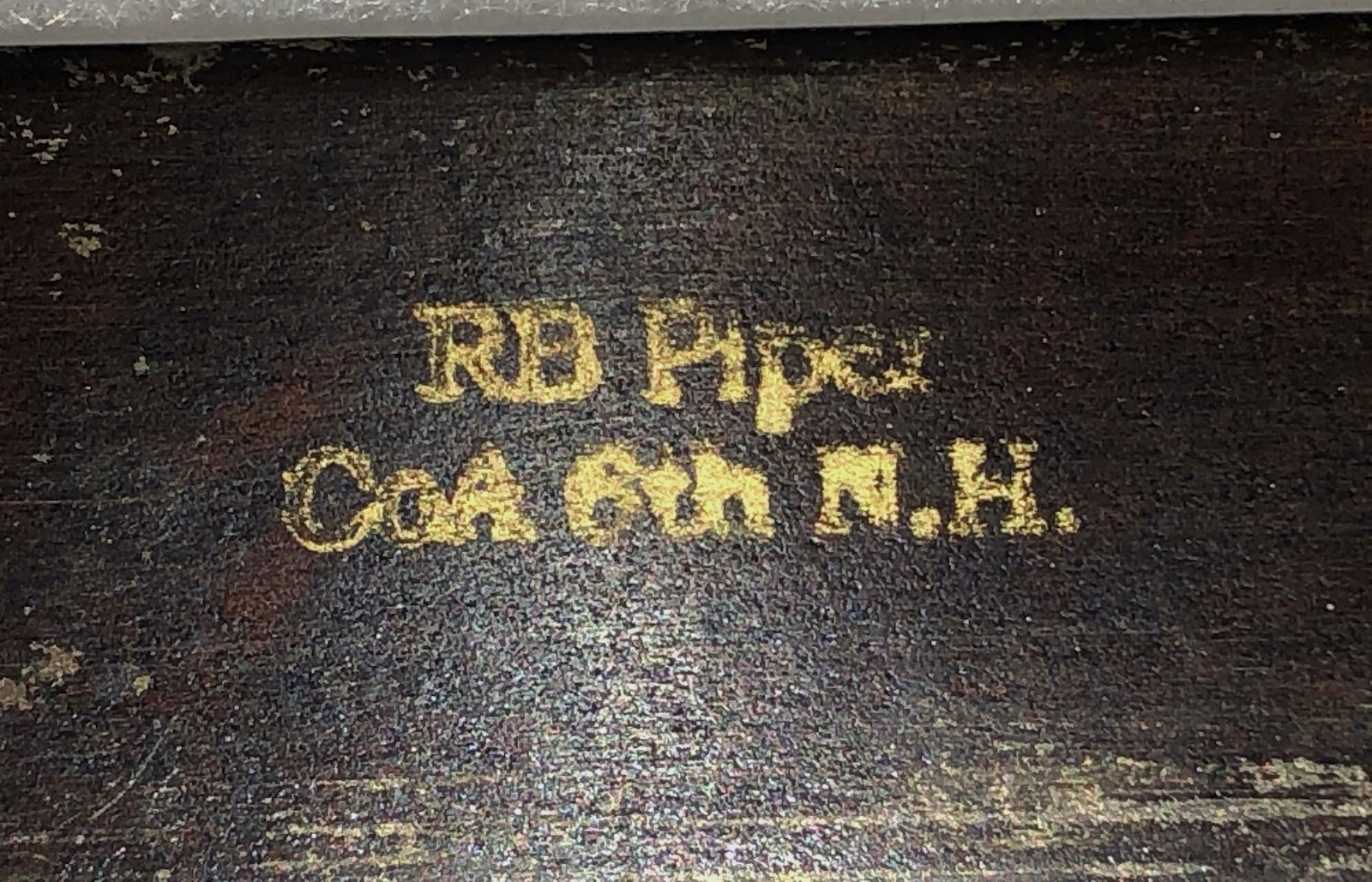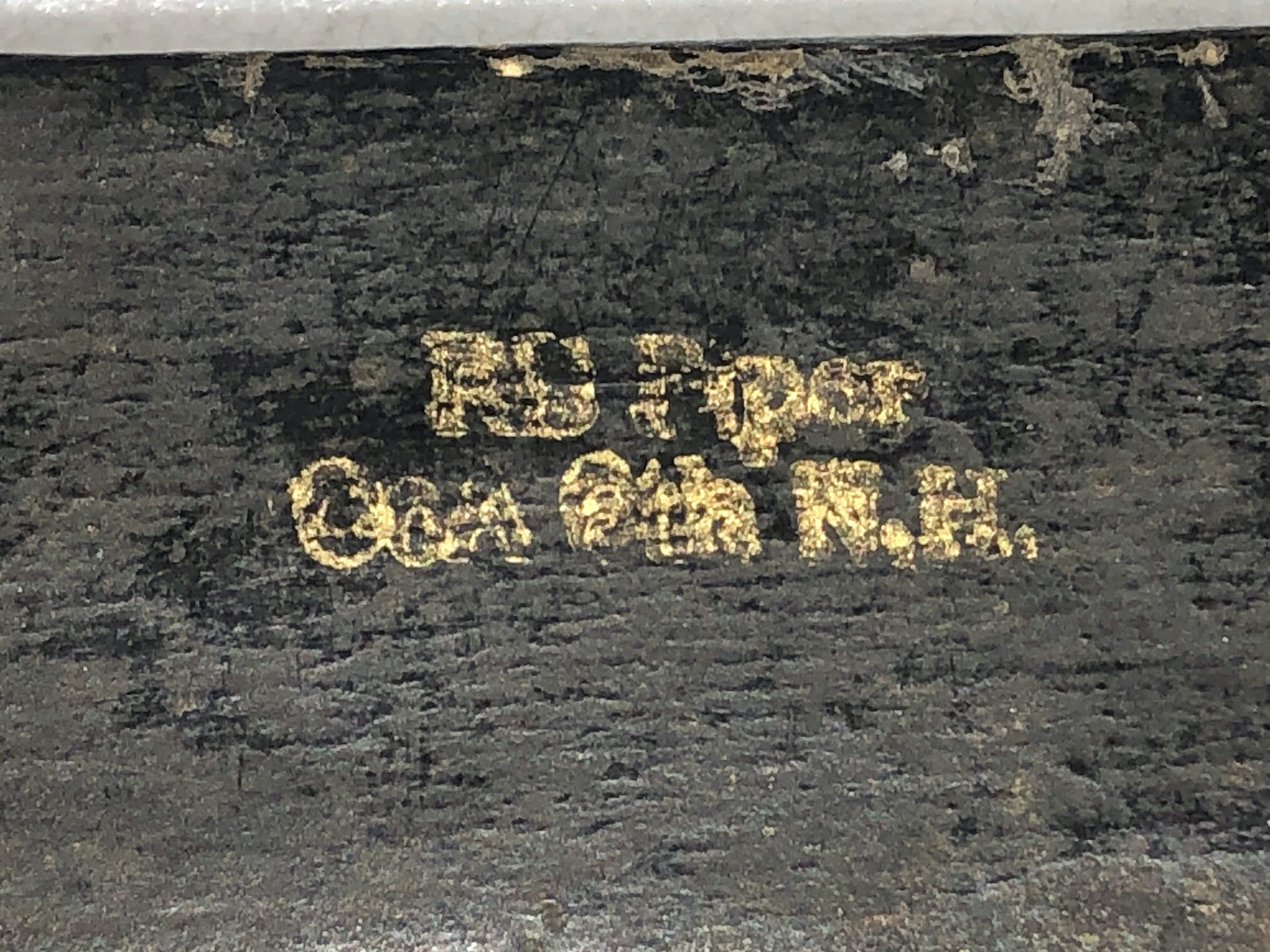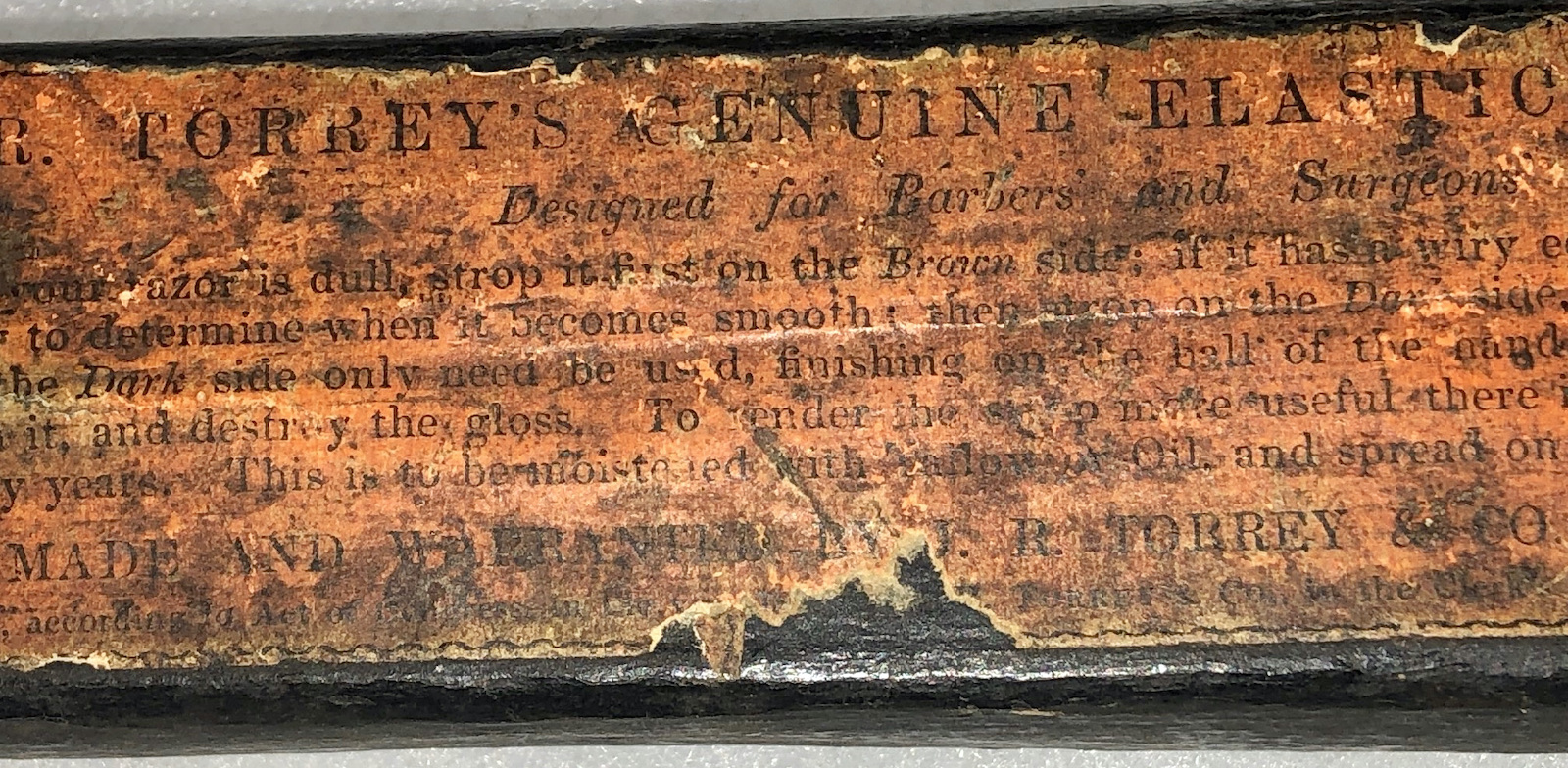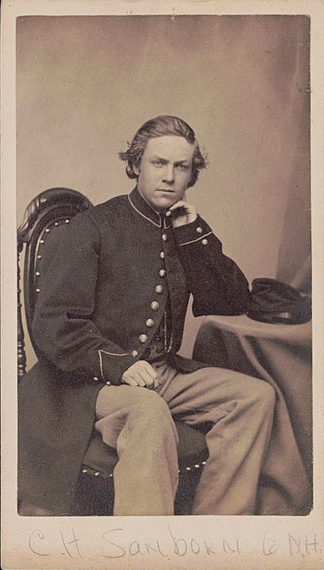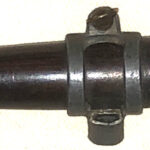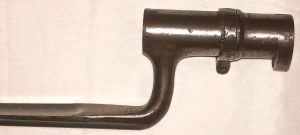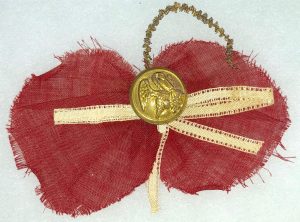Id’d Civil War Razor, Strop and Case – Corporal Robert B. Piper Co. A 6th New Hampshire Infantry
SOLD
Id’d Civil War Razor, Strop and Case – Corporal Robert B. Piper Co. A 6th New Hampshire Infantry – This complete set of a soldier’s shaving items includes the strop, its labeled case, razor tray and war period, straight razor. Embossed in gold lettering, on the strop case and razor tray is the following:
“RB Piper
Co A 6th N.H.”
The strop case exhibits its original, period label; the bone-handled razor, has its maker’s name, inset at the area just distal to the hinged attachment to the handle. The razor maker’s stamp reads as follows:
“MANUFACTURED BY
FREDERICK REYNOLDS
SHEFFIELD”
Robert Piper enlisted in Co. A of the 6th New Hampshire, at age 19, in December of 1861; he would serve throughout the first years of the war, then re-enlist, in the 6th NH, in January, 1864, and remain in that regiment until the end of the war. Piper was captured at Poplar Springs, Virginia, on September 30, 1864 and later paroled. During his service, Piper was promoted to the rank of Corporal. This is a fine shaving set, carried by a New Hampshire veteran, throughout numerous wartime engagements (see extensive battle record listed below). The shaving kit remains in excellent condition.
Robert B. Piper
| Residence Holderness NH; 19 years old.
Enlisted on 12/2/1861 as a Private. On 12/6/1861 he mustered into “A” Co. NH 6th Infantry He Re-enlisted on 1/3/1864 He was discharged on 5/30/1865 at Concord, NH He was listed as: * POW 9/30/1864 Poplar Springs Church, VA (Paroled) * Paroled 2/27/1865 (place not stated) Promotions: * Corpl Other Information: born in Holderness, NH After the War he lived in Holderness
|
6th NH Infantry
( 3-years )
| Organized: Keene, NH on 11/27/61 Mustered Out: 7/17/65 at Alexandria, VAOfficers Killed or Mortally Wounded: 10 Officers Died of Disease, Accidents, etc.: 3 Enlisted Men Killed or Mortally Wounded: 177 Enlisted Men Died of Disease, Accidents, etc.: 228 (Source: Fox, Regimental Losses) |
| From | To | Brigade | Division | Corps | Army | Comment |
| Jan ’62 | Apr ’62 | Williams’ | Burnside’s Expeditionary Corps | |||
| Mar ’62 | Jul ’62 | 4 | 3 | Department of North Carolina | ||
| Jul ’62 | Mar ’63 | 1 | 2 | 9 | Army of Potomac | |
| Mar ’63 | Jun ’63 | 1 | 2 | 9 | Army and Dept of Ohio | |
| Jun ’63 | Aug ’63 | 1 | 2 | 9 | Department of the Tennessee | |
| Aug ’63 | Oct ’63 | 1 | 2 | 9 | Army and Dept of Ohio | |
| Aug ’63 | Jan ’64 | District North Central, KY | 1 | 23 | Army and Dept of Ohio | |
| Feb ’64 | Apr ’64 | 1 | 2 | 9 | Army and Dept of Ohio | |
| Apr ’64 | Jul ’65 | 2 | 2 | 9 | Army of Potomac | Mustered Out |
SIXTH REGIMENT
NEW HAMPSHIRE VOLUNTEER INFANTRY.
( THREE YEARS )
| By LYMAN JACKMAN, late Captain Sixth Regiment New
Hampshire Volunteer Infantry,.and Historian of Regiment.
THE Sixth Regiment was organized at Keene, in November, 1861, the men coming from all parts of the State. The regiment camped on the Cheshire Fair Ground, about a mile and a half out from the city, the camp being called “Camp Brooks.” Company B was the first on the ground, reporting November 9. The men were mustered in November 27 to 30, the regimental organization being completed on the 30th.
On the 25th of December the regiment left Keene, and proceeded via Worcester, Norwich, and New York, to Washington, where it arrived at 4 P. M., on the 28th, and was assigned to Casey’s Provisional Brigade, in which it remained until January 6, 1862, being camped at Bladensburg, Md.
On the 6th of January the regiment started for Annapolis, Md., to join Burnside’s expedition to North Carolina. Arriving at Annapolis on the evening of the 7th, the regiment the next day went on board the steamer “Louisiana” and the ship “Martha Greenwood,” and arrived at Fort Monroe on the evening of the 10th. Here the whole regiment was crowded onto the “Louisiana,” and on the 11th started for Hatteras Inlet, arriving there about 5 P. M., the next day, after encountering a terrible storm on the way. The Sixth landed on the 17th and camped at “Camp Wool” on Hatteras Island. The camp being very unhealthy, the regiment, on the 24th, moved about two miles to ” Camp Winfield Scott,” where it remained until the 24th of February. On the 25th it embarked on the steamer ” Northerner,” and landed on Roanoke Island March 2, being assigned, on the 6th, to the Fourth Brigade, Department of North Carolina.
On the 8th of March six companies under Lieutenant Colonel Griffin, joined an expedition to Columbia, N. C., in search of a rebel regiment, said to be recruiting at that place; but the expedition returned without finding the enemy. On the night of April 7 Lieutenant Colonel Griffin, with four companies of the Sixth and two of the Ninth New York went to Elizabeth City, N. C., and broke up a rebel camp. On the 19th of April, General Reno, with four regiments and a battery, moved on Camden, N. C., and met the enemy about 3 o’clock in the afternoon, and a sharp fight ensued. The Sixth, by its handsome behavior here, won complimentary notice in orders.
On the 18th of June the regiment left Roanoke Island, and reached New Berne, N. C., the next day. During this month the Sixth was assigned to the First Brigade, First Division, Department of North Carolina.
On the 1st of July the Sixth embarked to join McClellan in Virginia; but it having been reported that Richmond had been captured, the regiment returned and landed at New Berne, July 5, but re-embarked the next day, and on the 10th landed at Newport News. The regiment was assigned on the 22d to the First Brigade, Second Division, Ninth Army Corps. On the 2d of August the regiment went on board transports, reached Aquia creek on the 4th, landed and proceeded by rail to Falmouth, Va., where it arrived late that night, and camped opposite Fredericksburg. August 12 the regiment left camp and marched to join Pope’s army, which was found near Culpeper, Va.
At Bull Run on the afternoon of the 28th the First Brigade was ordered to attack the enemy, who ,were posted in the woods. The Sixth with the Second Maryland on its right, made a gallant attack ; but the Forty-Eighth Pennsylvania, on its left, fell behind, and the Sixth being exposed to a murderous fire on its left flank, was compelled to fall back. This battle was the most disastrous to the regiment of any in which it participated, two hundred and ten being killed, wounded, or missing out of four hundred and fifty officers and men who went into the fight. On the next day the Sixth with its brigade acted as a support to the Second Brigade of the Second Division of the corps. The night of the 30th the Ninth Corps covered the retreat of Pope’s army. About 6 P. M., September 1, the enemy attacked the corps near Chantilly, Va., and the Sixth being brought into the fight, was engaged until dark, when the enemy withdrew.
The army then fell back to the defences of Washington; and here the Sixth remained until the 7th of September, when, with its corps, it moved; and passing through Frederick. Md., was at South Mountain on the 14th, being used with its division as a support. At Antietam on the 17th. the Sixth was again engaged, taking part in a charge made to take the “stone bridge” (afterwards known as “Burnside’s bridge”), on Antietam creek.
A few days later the regiment marched to Pleasant Valley, Md., remained until October 27, when the army left Pleasant Valley, crossed the Potomac by pontoon bridges at Berlin, and took up a line of march along the valley east of the Blue Ridge, with Richmond for its objective point. The regiment was now, with its division, in the advance of the army ; and on the 14th of November, being a part of the advance picket line, skirmished at Amissville. At Warrenton (or White Sulphur) Springs, November 15th, the regiment was lightly engaged.
On the 19th of November the regiment arrived at Falmouth in front of Fredericksburg, and camped north of the Phillips house until December 12, when it marched into Fredericksburg. At about 1 P. M., the next day, the Sixth, with its brigade, advanced to assault the enemy’s works on Marye’s Heights, and was engaged until dark. On the 15th it returned to its former camp-ground at Falmouth, and remained until the 10th of February, 1863 when it was sent to Newport News.
Orders were received on the 20th of March to break camp and take transports to Baltimore, and from thence to proceed by rail to Cincinnati. The Ninth Army Corps was ordered to report to General Burnside, who had been transferred to the Department of the Ohio. As the central and southern portions of Kentucky were being plundered by the rebels, General Burnside decided early in April to send the Ninth Corps into that State. Accordingly the Sixth proceeded to Lexington, Ky., and from thence to Winchester, on the 8th of April; and leaving Winchester on the 16th, arrived at Richmond (Ky.), on the 18th. The regiment then proceeded to Paint Lick creek on the 3d of May, and to Lancaster on the 10th. Remaining there until the 23d, when it advanced to Crab Orchard, with a view to joining in the movement upon East Tennessee, then contemplated by General Burnside. Orders for the movement were countermanded, however, and on the 4th of June the regiment left Crab Orchard; and at evening on the 6th, reached Cincinnati, where the night was spent. The next morning the regiment left Cincinnati, and reached Cairo on the 8th, went on board the steamer “General Anderson” the next day, and passed down the Mississippi river to join General Grant in his operations against Vicksburg.
On the 13th of June the fleet reached Milliken’s Bend, and on the 14th the Sixth disembarked near the canal dug by General Williams to turn the river so that the Union boats might pass Vicksburg unmolested. On the 15th the regiment marched southwest to a point on the river about ten miles below Vicksburg, returning the same day; and on the morning of the 16th, went up the Yazoo river to Haynes’ Bluff, and camped at Milldale, about a mile distant. Here the regiment remained until the 22d, when it marched eastward, and on the 25th came upon some of the enemy’s outposts near the Big Black river. After waiting here a few days the movement was continued July 1st to Oak Ridge. Vicksburg surrendered on the 4th, and the Sixth immediately started with the army in pursuit of the enemy under General Johnston. The rebels made a stand at Jackson, Miss., and here the Sixth was engaged from the 10th to the 17th, when it was discovered that Johnston had evacuated the city. On the 20th the army began its return march, and three days afterward the Sixth reached its old camp at Milldale. Here the regiment remained until August 8, when it embarked and made its way up the river to Cairo and thence by rail to Cincinnati, which was reached on the 20th. On the 23d the Sixth proceeded by rail to Nicholasville, and camped a few miles from the village near Camp Nelson, Ky.
On the 9th of September the Sixth was sent to Frankfort to do provost duty. Leaving Frankfort the 24th, the regiment reached Russellville the next day, where it remained until the 26th of October; then it left for Camp Nelson to perform provost duty, and arrived there the next day. While here many of the men re-enlisted, and on January 16, 1864, the re- enlisted men left for New Hampshire to spend the furlough of thirty days granted by terms of re-enlistment. They were afterwards re-furloughed, and did not leave the State until the 18th of March, when they proceeded to Annapolis, Md., to join the Ninth Corps, then re-assembling at that place. The remainder of the regiment joined, and -the Sixth was assigned to the Second Brigade, Second Division, Ninth Army Corps, April 20. On the 23d of April the regiment marched with its corps to join the Army of the Potomac, reaching it in time to take part in the battle of the Wilderness on the 6th of May, where, with the Second Brigade, it made an heroic charge, capturing a large number of prisoners. From the 8th to the 20th, the Sixth was at Spottsylvania, being severely engaged on the 12th and 18th. Starting on the 21st, the regiment pushed on to the North Anna river, where it was in the reserve from the 23d to the 25th, and was in the front line on the 26th, when Lieutenant-Colonel Pearson was killed. The army moved on the night of the 26th, towards Totopotomoy creek, where the Sixth was engaged on the 30th and 31st.
June 2 and 3 the regiment was engaged near Bethesda Church, and from the 4th to the 12th, was under fire at Cold Harbor. On the night of the 12th the army withdrew, and at Noon of the 16th the Ninth Corps arrived in front of Petersburg. Here the regiment was constantly under fire until the 20th of August, taking part in the assault following the explosion of the “Mine” on the 30th of July. August 20 the corps withdrew and moved to the Weldon Railroad. Here on the 20th and 21st, the Sixth assisted in repelling two desperate attacks made by the rebels. A new line of intrenchments was thrown up, connecting with those formerly held, and the regiment remained here under fire until September 30.
On the 30th of September and the day following, the Sixth was engaged near Poplar Springs Church, about one hundred and twenty-five officers and men being killed, wounded, or captured. Works were thrown up, and the regiment remained here until early in December, participating without loss in the engagement at Hatcher’s Run, on the 27th of October.
Early in December the corps returned to its original position in front of Petersburg, the Sixth lying in rear of Fort Alexander Hays until April 1, 1865. While here the regiment took part in a reconnoissance to Nottoway Court House, December 10,11, and 12,1864. On the night of April 1, 1865, the Sixth, with its brigade, made a successful attack on the enemy’s works to the left of Fort Davis, and on the morning of the 2d participated in a second successful attack near Fort Sedgwick.
From Petersburg the regiment marched in pursuit of Lee’s army, arriving at Burkeville on the 9th of April. On the 20th the regiment marched for City Point, and leaving there on the 26th, embarked on the steamer “D. R. Martin.” Alexandria was reached the next day, where the regiment remained in camp until mustered out on the 17th of July. On the 18th of July the regiment left Alexandria, and proceeded by rail to New York, thence by boat to Norwich, and arrived at Concord, July 23.
The regiment during its term of service served in seventeen different states; meeting all the requisitions of duty, however onerous or perilous, with cheerful and ready efficiency. While it is not asserted that the Sixth was the best regiment sent out from New Hampshire, the claim may be made, and can be maintained, that it was equal to the best. Its record has added a brilliant chapter to the history of New Hampshire’s always glorious achievements in war.
The Sixth New Hampshire Volunteers was attached to General Casey’s Provisional Brigade, near Washington, D. C., December 28, 1861; General Burnside’s Expedition to North Carolina, January 6, 1862; Fourth Brigade, Department of North Carolina, March 6, 1862; First Brigade, First Division, Department of North Carolina, June, 1862; First Brigade, Second Division, Ninth Army Corps, July 22, 1862; District of Kentucky, Department of Ohio, September 9, 1863; on Veteran Furlough, January 16, 1864; in Ninth Army Corps, unassigned, March, 1864; Second Brigade, Second Division, Ninth Army Corps, April 20, 1864.
E N G A G E M E N T S : Camden, N.C. Apr. 19, 1862 Bull Run, Va. Aug. 29, 30, 1862 Chantilly, Va. Sept. 1, 1862 South Mountain, Md. Sept. 14, 1862 Antietam, Md. Sept. 17, 1862 White Sulphur Springs, Va. Nov. 15, 1862 Fredericksburg, Va. Dec. 13, 1862 Siege of Vicksburg, Miss. June 14 to July 4, 1863 Jackson, Miss. July 10-16, 1863 Wilderness, Va. May 6, 1864 Spottsylvania, Va. May 8-20, 1864 North Anna River, Va. May 23-26, 1864 Totopotomoy, Va. May 30,31, 1864 Bethesda Church, Va. June 2,3, 1864 Cold Harbor, Va. June 4-12, 1864 Siege of Petersburg, Va., June 16, 1864 to Apr 3, 1865 Mine Explosion, Petersburg, Va. (assault) July 30, 1864 Weldon Railroad, Va. Aug. 20-22, 1864 Poplar Springs Church, Va. Sept. 30, Oct. 1, 1864 Hatcher’s Run, Va. Oct. 27, 1864 Petersburg, Va. Apr. 1, 2, 1865 |
| 6th New Hampshire Infantry Regiment | |
| Active | November 27, 1861, to July 17, 1865 |
| Country | United States |
| Allegiance | Union |
| Branch | Infantry |
| Size | 1,030 (Original Enlistment) 2,574 (Including Recruits) |
| Engagements | Battle of Groveton Second Battle of Bull Run Battle of Chantilly Maryland Campaign Battle of South Mountain Battle of Antietam Battle of Fredericksburg Siege of Vicksburg Battle of the Wilderness Battle of Spotsylvania Court House Battle of Totopotomoy Creek Battle of Cold Harbor Siege of Petersburg Second Battle of Petersburg Battle of the Crater Battle of Hatcher’s Run Appomattox Campaign Third Battle of Petersburg |
| Commanders | |
| Notable commanders |
Colonel Simon Goodell Griffin |
| New Hampshire U.S. Volunteer Infantry Regiments 1861-1865 | |
| Previous | Next |
| 5th New Hampshire Infantry Regiment | 7th New Hampshire Infantry Regiment |
Private Charles H. Sanborn of Co. A, 6th New Hampshire Infantry Regiment. From the Liljenquist Family Collection of Civil War Photographs, Prints and Photographs Division, Library of Congress
The 6th New Hampshire Infantry Regiment was an infantry regiment that served in the Union Army during the American Civil War.[1]
Service
The 6th New Hampshire Infantry was organized in Keene, New Hampshire, and mustered in for a three-year enlistment on November 27, 1861.
The regiment was attached to Williams’ 4th Brigade, North Carolina Expedition, to April 1862. Hawkins’ Brigade, Department of North Carolina, to July 1862. 1st Brigade, 2nd Division, IX Corps, Army of the Potomac, to March 1863. 1st Brigade, 2nd Division, IX Corps, Department of the Ohio, to June 1863. 1st Brigade, 2nd Division, IX Corps, Army of the Tennessee, to September 1863. Bixby’s Brigade, District of North Central Kentucky, 1st Division, XXIII Corps, Department of the Ohio, to February 1864. 1st Brigade, 2nd Division, IX Corps, Army of the Potomac, to April 1864. 2nd Brigade, 2nd Division, IX Corps, Army of the Potomac, to July 1865.
The 6th New Hampshire Infantry mustered out of service July 27, 1865.
Detailed service
Left New Hampshire for Washington, D.C., December 25, 1861. Expedition to Hatteras Inlet, N.C., January 6–13, 1862, and duty there until March 2. Moved to Roanoke Island March 2 and duty there until June 18. Expedition to Elizabeth City April 7–8. Battle of Camden, South Mills, April 19. Expedition to New Berne June 18-July 2. Moved to Newport News, Va., July 2–10, and duty there until August 2. Moved to Aquia Creek and Fredericksburg, Va., August 2–7. Pope’s Campaign in northern Virginia August 16-September 2. Battles of Groveton August 29; Second Bull Run August 30; Chantilly September 1. Maryland Campaign September–October. Battle of South Mountain, Md., September 14. Battle of Antietam, September 16–17. Duty in Pleasant Valley, Md., until October 27. Movement to Falmouth, Va., October 27-November 19. Corbin’s Cross Roads, near Amissville, November 10. Sulphur Springs November 14. Battle of Fredericksburg, Va., December 12–15. Burnside’s Second Campaign, “Mud March“, January 20–24, 1863. Moved to Newport News, Va., February 11; then to Lexington, Ky., March 26-April 1. To Winchester, then to Richmond, Ky., April 18. To Paint Lick Creek May 3, and to Lancaster May 10. Movement to Vicksburg, Miss., June 3–14, Siege of Vicksburg June 14-July 4. Advance on Jackson, Miss., July 4–10. Siege of Jackson July 10–17. At Milldale until August 5. Moved to Cincinnati, Ohio, August 5–20; then to Nicholasville, Ky. Provost duty at Nicholasville, Frankfort, and Russellville until October 25. Moved to Camp Nelson, Ky., and provost duty there until January 16, 1864. Regiment veterans January 1864, and on furlough January 16 to March 10, when ordered to Annapolis, Md. Non-veterans at Camp Nelson, Ky., until March. Campaign from the Rapidan to the James May 3-June 15. Battles of the Wilderness, Va., May 5–7; Spotsylvania May 8–12; Spotsylvania Court House May 12–21. Assault on the Salient at Spotsylvania Court House May 12. North Anna River May 23–26. On line of the Pamunkey May 26–28. Totopotomoy May 28–31. Cold Harbor June 1–12. Bethesda Church June 1–3. Before Petersburg June 16–19. Siege of Petersburg June 16, 1864, to April 2, 1865. Mine Explosion, Petersburg, July 30, 1864. Weldon Railroad August 18–21. Poplar Springs Church September 29-October 2. Hatcher’s Run October 27–28. Garrison of Fort Alexander Hays until April 1865. Appomattox Campaign March 28-April 9. Assaults on and fall of Petersburg April 2. Occupation of Petersburg April 3. Pursuit of Lee to Burkesville April 3–9. Moved to Washington, D.C., April 20–27. Duty at Alexandria until July. Grand Review of the Armies May 23.
Casualties
The regiment lost a total of 418 men during service; 10 officers and 177 enlisted men killed or mortally wounded, 3 officers and 228 enlisted men died of disease.
Listed on the New Hampshire State Memorial. This unit was attached to Col. Simon G. Griffin’s 1st Brigade of Brig. Gen. Robert B. Potter’s 2d Division, Maj. Gen. John G. Parke’s IX Army Corps (Detachment) on Maj. Gen. William T. Sherman’s Exterior Line and was commanded by Lt. Col. Henry H. Pearson. [Refer to Griffin of New Hampshire.]


